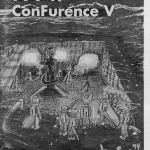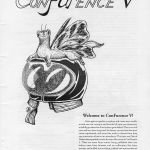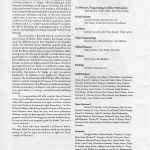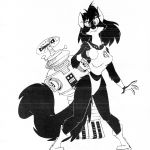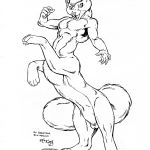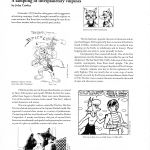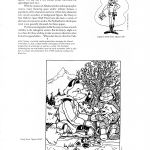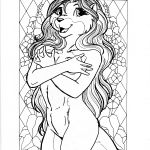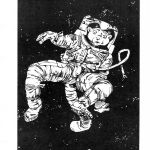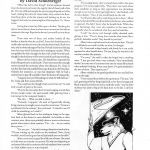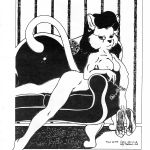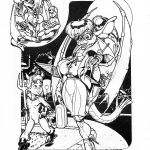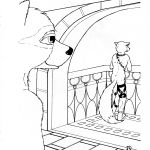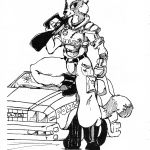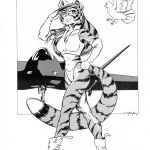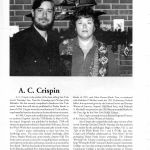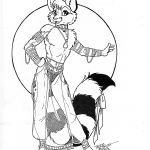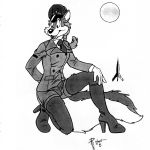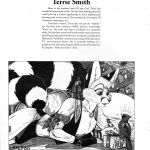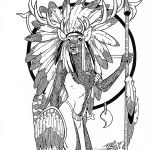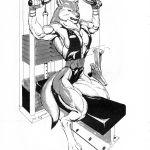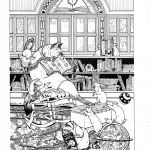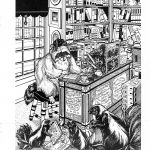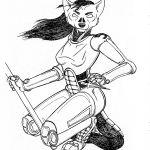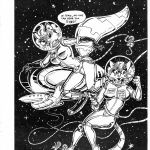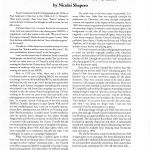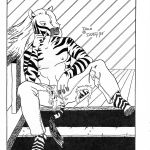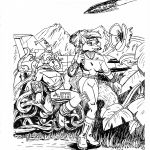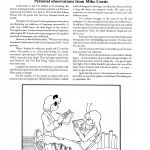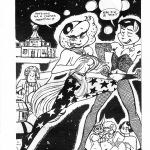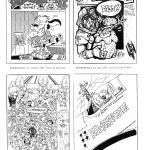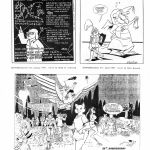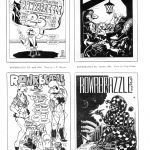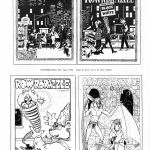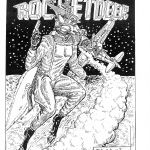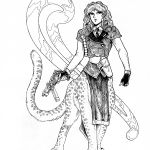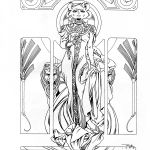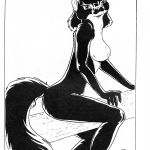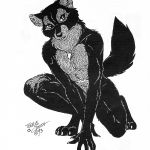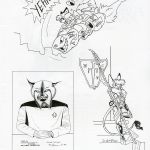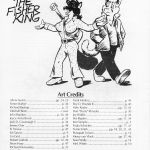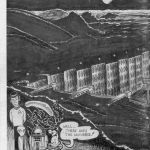Welcome to ConFurence V!
Once again we gather to explore and create new worlds, to seek out new concepts and breathe life into new characters, to boldly go where few Furries have gone before! This is our 6th year, and my, have we grown! As always, our art show has more artists represented, and more fine work to choose from then any convention of twice our attendance. This year, our Den of Dealers has expanded to twice the size of the room at ConFurence 3. There are more furry comics being published then ever before; more furry fanzines and art collections; fine furry statuary and stuffed toys are being crafted; and more artists are accepting commissions and have prints available of their work. ConFurence is the best place for all of us furry fans to satisfy our obsession as well as meet and support our friends, the creators of the genre.
The furry experience is intensely visual, and often the wordsmiths who paint their images on the canvas of our minds feel neglected. Something new this year, which we hope will become a tradition, is our first Writers’ Workshop. Our Guest of Honor, author A. C. Crispin, will be holding one of her interactive workshops on all aspects of writing. She will be critiquing the work of some of our members, and holding a 3 hour seminar to discuss everything from proper presentation of a manuscript, technique and style, to the most important subject, how to get your work published! In keeping with another ConFurence tradition, Michael Capobianco, author of Burster, and A. C. Crispin’s partner, will also be our guest. He will be discussing the cosmological aspects of universe creation, and astrological mythology in Special Interest Group meetings. Our convention is honored this year to have two fine Artist Guests of Honor. Alicia Austin’s fine fantasy art has made the difficultcrossover from Fandom to the mundane world. Her beautiful Native American inspired cards and prints are sold in many fine galleries and gift shops all over the world. Jinx Beers, Alicia’s long-time agent and assistant, will be joining us as well. Sharing the spotlight with Ms Austin is our good friend, the incredibly prolific Terrie Smith. Her art has been well known in Fandom for many years, and her variety of fantastic art prints are highly prized in Furrydom. Terrie has graciously donated her talent to ConFurence many times, designing the T-shirt and theme poster for ConFurence 4 and providing illustrations for badge art and convention publications. In addition to her graphic art, Terrie is an animator. She contributed her skills to the short film, The Diner, which is currently touring the US as part of the International Tourney of Animation. Glen Wooten, her husband and agent, will also be attending ConFurence. He will be on hand with some good advice on running a successful small publishing business. Our programming will offer popular Special Interest Group topics of the past, as well as some new ones. The species clubs will be open for business once again, and don’t miss the Ice Cream Social, or the Saturday night Pizza dinner. Our Fur le Dance Cabaret, which raises funds for charity, will be an even more fantastic show them last year, with more performers offering a variety of dancing styles. Some new events on the program are the Life Drawing group and the FurRave dance. Be sure to check your program guide for details. You won’t want to miss out! For those who have attended ConFurence before, Welcome Back! For our new members, thank you for giving visiting us, and we hope you will join us again for future “voyages of discovery”.
ConFurence Credits
Co-Directors, Programming, Facilities, Publications: Mark Merlino, Rod O’Riley, John Alan Stanley
Hotel Facilities: Airporter Garden Hotel, Irvine, CA Ann Harris, Conference Service Coordinator
Art Show: Jazmyn Concolor, John Alan Stanley, Vicky Levitin
Video Programming: James Lomax, Henry Brown Jr., Avi Melman
Official Mascots: Sydney Fisher, Cairn Fisher, Five Fur!
T-Shirts: Mitch Beiro, Ken Bolland
Printing: A E Press, Concord, CA
Staff Members: Larry Adams, Don Barrett, David Bliss, Gearl Brace, Henry Brown Jr., Jazmyn Concolor, Farix, Mario D’Anna Jr., Timothy Fitelson, Steve Gattuso, Charles E. Gray, Darren Hanson, Brian Henderson, Lori Henderson, David Klinkler, Vicky Levitin, James Lomax, Avi Melman, Mark Merlino, Kurt Miller, Charles Nezzer, Ken Nielsen, Rod O’Riley, Lewis Peterson Jr., Waverly Pierre, Shayn Raney, Kay Shapero, John Alan Stanley, Gary Wells, Granite Wolf
Super Sponsors! Richard D. Brooks, Cody Buchmann, Alan B. Coe, Samuel Conway Jr., Larry Dixon, David Ewell, David Fenger, David M. Friedman, John R. Gardner, Pete Glaskowsky, Michael Hackett, Ron Johnson, Richard Lewis, Sean Malloy, Jeff Mancebo, Dennis W. Province, Bruce G. Rowe, Mark L. Severson, John Alan Stanley, DeWayne Stewart, Richard F. Thatcher
Sponsors: Douglas Baker, Hubert Bartels, Thomas G. Brady, Rob Clark, Michael T. Danaher, David DeSimone, Nancy DeSimone, Bernard Doove, Bryan Feir, Lanny Fields, Don Fitch, Scott Gosik, Johnathan Hammar, Arlene Harris, Philip D. Jacobs, Jason Jensen, Jeffrey Scott Jonas, Robert C. King, Juan F. Lara, Walter A. Lyzohub Jr., Jordan M. Montgomery, Matthew Sabins, Ken Smith, Tim Susman, Porsupah Toliani, Jim Trimble, Dana Uehara, Tara Wells, Jacob Adam Wright, Leonard Zubkof
Barlowe’s Guide To My Brain
by Rod O’Riley
I first began following science fiction as a genre because of Edgar Rice Burroughs and Doctor Who. Not enough to consider myself a capital-F Fan yet at the time, but enough to note that there was an interest there, and a compelling one at that. As I suspect was true for a lot of people, my—descent? ascent?—movement into real fandom got a considerable shot in the arm with the publication of Barlowe’s Guide to Extraterrestrials in 1979. Simply intended as a collection of full color illustrations of ‘Great Aliens from Science Fiction Literature’ (to quote the front cover), to a young and growing SF fan it was a ‘Cliff Notes’ for several well-known and lesser- known science fiction novels, and a quick guide for finding books that would have interesting aliens in them. I had already recognized that a very large part of my interest in science fiction (and, to a lesser extent, fantasy) came from an interest inside me for strange and unusual alien cultures and peoples. (Most of us hadn’t even thought of terms like ‘furry’ or ‘anthropomorphic’ yet; we just knew what we liked was aliens, especially if they looked like terran animals.) So, with more than a little well-placed begging, I got the book for Christmas that year, and was off like a shot. I made a mistake at first: the first book I read out of the Guide was Arthur C. Clarke’s Childhood’s End, followed closely by A Case of
Conscience by James Blish—without a doubt, two of the most depressing SF books ever written! Wouldn’t you know it, my saving grace back into liking SF would be furries—specifically, the Tran from Alan Dean Foster’s Icerigger. That book was a crackling good adventure, with well thought-out, likable characters and an interestingcultural backdrop, and a lot less people died in it! Okay, I thought, maybe I’ll give this science fiction stuff just a bit more of a chance. For a while after that, most of the SF books I chose to read were books described in the Guide. And there are numerous furries and sort-of furries described in the book: the ursine Dilbians from Spacial Delivery and Spacepaw by Gordon R. Dickson, not to mention the Ruml from his The Alien Way. The Ishtarian cat-taur warriors from Poul Anderson’s Fire Time. And the lemur-like Vegan space-cops from Robert Heinlein’s Have Spacesuit, Will Travel. In fact, the Mother Thing from that very book by Heinlein was the very first furry in SF that I ever fell madly, passionately in like with. To be sure, I’d soon discover there was a whole world of furries in SF stories that didn’t get put into Barlowe’s Guide. Any number of creatures from Poul Anderson books, from the Hoka to the bird-like People of the Wind. And H. Beam Piper’s Fuzzies. Gordon R. Dickson’s otteroids in Alien Art. And the myriad worlds and characters from the works of Andre Norton. And on and on and on but, those I would pick up on my own, having been a voracious reader ever since those innocent young days. Still, I’m indebted to Mr. Barlowe for giving a young SF fan just the jump-start he was looking for.
Stellar Foxes
A sampling of interplanetary vulpines
by John Cawley
Nintendo’s 1993 StarFox video game, with its aggressive advertising campaign, finally brought interstellar vulpines to mass attention. But foxes have traveled among the stars for at least three decades before this joystick space jockey. The fox has been a popular character in literature and art since both began. He has generally been a creature of the Earth, found in fables, medieval tales and tales set in medieval time focusing on the Earth, its inhabitants and its history. Planet hopping does not seem to come naturally to them. Interplanetary foxes started off slowly. One of the first appearances were the Aleriona, the interstellar fox race in Poul Anderson’s The Star Fox (1964, 1965). Like most of their more modern counterparts, these foxes stood upright. The plot concerned their attempt to conquer the planet of New Europe. Galactic vulpines were key in the fox explosion of the early Eighties. This was mostly due to a new crop of artists inspired, in youth, by the Disney animated feature Robin Hood (1973). The fox’s rise to cosmic character occurred in the world of apas and alternative comics. 1984 found the start of the apa Rowrbrazzle, co-created by Marc Schirmeister and myself. Within the first few issues, stellar foxes began to flourish. Most were mere illustrations. Two of the earliest creations, both named “Star Fox”, offered actual characters and stories. One was a graphic version, created by Tim Fay. His Star Fox was a female space pirate in the Captain Harlock mold. She appeared in several short stories in a variety of publications. Competing with her were Randy and Cindy, created by Robert Carspecken. A mostly text feature, this pair of normal Earth foxes were transformed into bipedal, anthropomorphic creatures as part of a plan to establish contact with other
1985 found Ken Mitchroney’s Space Ark debut. Its star was Captain Stone, a fox. The series sadly only ran five issues. That same year found the Japanese adult manga Galaxy Fox appear. The star was a very human female with some fox appendages (tail, etc.). With the creation of Albedo and other anthropomorphic comics, many featuring space and/or military themes, a population of fox characters was born. Often these characters were merely secondary or background figures, like Rusty in Dan Flahive’s Space Wolf. There have also been a variety of alternate universe series, such as The Furkindred, in which space travel is not generally discussed, but foxes appear. The literate and graphic stellar fox may not have as much visibility as the videogame version. But his history, slight as it is, is there for those wishing to take a journey where few other furries have gone before… Where else, but on a Star Fox Trek. Captain Stone from “Space Ark”
John Cawley, currently studio production manager for Marvel Animation, is also a noted author and expert on the history and production of animation as well as a writer. He has been collecting fox art and books since the early seventies. John is also the co-winner of ConFurence IV’s (1993) costume contest, the Blue Fox.
Genassist
by David Schneberger
“What the hell is that thing?!” the lab assistant shouted from the doorway as he saw the cage by the left hand wall of the lab. The tray of blood samples he was carrying dropped out of his hand, making him dive for them before they reached the floor. Snatching them at the last minute and looking up he saw the haggard, and none too reassuring face of his employer, Dr. Alison Graia. Giving him a hand up Albert got to his feet. Thanking the doctor, he set the tray down and went over to examine the hideous creatures in the cage. Repulsed as he was, he was still curious about them. There were two of them, and neither looked all that healthy, at least by what he could tell. From their body features he could make out that one was male and the other female. Both were sick, and in advanced stages of fur loss. He had a hard time looking into their eyes which bracketed their misshapen muzzles. When one grabbed for him through the bars with a fully-formed hand, though, he backed away as if he were scared of catching something. Albert tried to remain calm. He should have expected this kind of thing when he took the job. There were more than enough rumors around the university about the infamous Dr. Graia. It was that fact that had enabled him to get this job in the first place. Nobody else wanted it, or was that desperate. Still, he had a student loan to pay off, and didn’t have the luxury of being picky. “I suppose now you’ll be asking me what the hell these are.” Dr. Graia said from across the lab. “You could say the thought had occurred to me!” he said with a touch of panic in his voice. “They’re the two strays that’ve been hanging around here the last couple weeks,” she said casually while glancing from a microscope to the computer beside it. “But why… What you did to them…” “Curiosity, I suppose,” she said, as if genetically altering living creatures overnight was an everyday occurrence. “Science is a profession for the curious,” she continued. “I wanted to see if I could do something, so I tried it.” Albert glanced back to the misshapen things in the cage, then back to the doctor in utter disbelief. As horrible as these creatures were, there were probably three or more revolutionary genetic discoveries in their creation. “Do… do… do you realize what you’ve…” “Yes, yes, yes…” she said, waving a dismissive hand at him. “I’ll start writing up the results on the weekend. Now, if you wouldn’t mind handing me that vial just beside you on the table?” Albert continued to gape like a fish out of water. She acted as if this were an everyday occurrence. He was now beginning to understand why the last assistant she had employed
was currently in a little rubber room in some hospital. As it seemed to be useless to impress on her the gravity of these discoveries, he turned his questions to the practical. “Well what do you intend to do with these… these… things, now that they’re like this?! Keep them as pets?! Let them curl up by your feet?! My God, they must be over five and a half feet tall!!” “If you must know, they’ve already been sold to the space program.” Dr. Graia replied icily. “They don’t care much about their condition so long as they approximate our physiology enough to test out the new hyper-light drive,” she finished, with obvious disdain. “Now, if you would hand me the vial. “It still seems like such a cruel thing to do to them “ Albert said as he handed off the small test tube to the doctor, who nodded in approval. He didn’t know what he should think. While they were fascinating, they were also repulsive at the same time, especially when he considered what they used to look like. “Look!” the doctor said through visibly clenched teeth, glaring at him. “They’re being shot towards what seems like perfectly habitable world! They should be just fine!” Albert took a step backward as she shouted at him. This job was definitely not worth six-fifty an hour, he thought. Dr. Graia took a deep breath, and slowly let it out as she appeared to calm herself down. The last thing she wanted to do was lose another lab assistant. “I’m sorry,” she said in what she hoped was a soothing voice. “I just get tired when every assistant I hire immediately thinks I’m some sort of a monster that eats the excess lab animals when nobody’s looking. If you must know, I’m quite attached to the two of them. That surprise you?” Albert nodded as she gently grabbed his arm and led him over to the cage. “I even named them before the experiment. This one,” she said, gesturing with her long striped tail, as her furred orange and black striped face broke out into a motherly smile, “was the little monkey that used to beg at the back door to the lab. I call him Adam.”
A. C. Crispin
A. C. Crispin is the author of the best-selling Star Trek novels Yesterday’s Son, Time For Yesterday, and The Eyes of the Beholders. She has recently completed a hardcover Star Trek novel, Sarek, that will also be published by Pocket Books in June of 1994. Crispin wrote the novelization of V, the million- copy bestseller based on the science-fiction television miniseries.
In 1984, Crispin and noted fantasy author Andre Norton co-authored Gryphon’s Eyrie for TOR Books. In May of 1992, the sequel, Songsmith, was published in hardback. TOR will release the paperback edition in September of this year. Fans of the Witch World have reacted enthusiastically to both works.
Crispin’s major undertaking to date has been her StarBridge series. The series titles include Starbridge, Silent Dances, Shadow World, and, most recently, Serpent’s Gift. The books center around a school for young diplomats, translators and explorers, both alien and human, located on an asteroid far from Earth. The first four books of the series have been released by ACE Books, and Book Five, Silent Songs , will be forthcoming in spring of 1994.
Starbridge Book One was placed on the American Library Association’s Young Adult Services Division’s list of Best
Books of 1991, and Silent Dances (Book Two, co-authored with Kathleen O’Malley) made the 1991 Preliminary Nebula ballot, the top award given by the Science Fiction and Fantasy Writers of America. Serpent’s Gift (Book Four, with Deborah A. Marshall) was placed on the 1993 Recommended Books for the Teen Age by the New York Public Library.
Ms. Crispin currently serves as Eastern Regional Director of the Science Fiction Writers of America.
Ann Crispin also scripted the audio tape versions of her novels Yesterday’s Son and Time for Yesterday. She has authored short stories for the anthologies Magic in Ithkar, Vol. 3, and Tales of the Witch World, Vol. 1 and 3 (TOR). Last year, Crispin and O’Malley collaborated on “Pure Silver” for the prestigious Byron Preiss horror anthology, The Ultimate Werewolf. Ms. Crispin’s teaching credits include a semester- long “Writing for Profit” course at Charles County Community College, two two-day writing workshops for Harrisburg Area Community College, a two-day writing seminar at Towson State University, and numerous mini-workshops at science fiction and Star Trek conventions, where she is a frequent guest.
Michael Capobianco
Michael Capobianco has published one solo science fiction novel, Burster (Bantam 1990). He is co-author, with William Barton, of the controversial hard sf book Iris (Doubleday 1990, Bantam paperback 1991) and the critically acclaimed near-future novel Fellow Traveler (Bantam, 1991), as well as several magazine articles on planetology and the exploration of the solar system. He lives in Northern Virginia, where he is currently working on Alpha Centauri, a third collaboration with William Barton.
Born in Washington, D.C. in 1950, Capobianco graduated from the University of Virginia with a major in General Linguistics and a minor in Russian. For many years he has been involved in the development of computer simulations
and game software, and is a founding partner and CEO of Not- Polyoptics, a software company specializing in orphan computers. An amateur astronomer and eclipse-chaser, he is a member of the International Occultation Timing Association (IOTA). The satellites of the outer solar system as revealed by the Voyager spacecraft continue to fascinate him. Capobianco also has a strong interest in Russian literature. He is presently serving as Treasurer of the Science Fiction and Fantasy Writers of America (SFWA).
Terrie Smith
Born in the mythical land of Cape Cod, Terrie has traveled all around the world. She has been drawing since she could pick up a crayon (graduating to more sophisticated drawing tools in later years). She attended the University Of Tennessee, majoring in art.
Contrary to rumor, Terrie does not just do “
her popular “Medicine Shield” series.
Alicia Austin: A Brief Bio
Alicia Austin followed in her family’s artistic footsteps by beginning her own creative drawings at the age of six. She spent her formative years as an “army brat,” absorbing the different styles and philosophies of schools and artists in Texas, California, Arkansas, Germany, Japan and Canada before discovering her special penchant for fantasy art.
After attending Houston’s Sacred Heart Dominican College on an art scholarship, Alicia studied art, biology and comparative anatomy at the University of Houston with thoughts of becoming a medical illustrator. She then moved to Canada where a college club science fiction and fantasy magazine “coerced” her into doing their illustrations. Thus a hobby was born.
Shortly thereafter Alicia displayed her work at the 1969 World Science Fiction Convention in St. Louis, where every piece was purchased during the first two days of the five day art show. She was also contacted there by her first professional editor, and subsequently was published in 1971 in New Worlds of Fantasy 3. Thus a career was born.
Over the years Alicia has interpreted European, Russian, Oriental and other ethnic folklore and mythology. Says Alicia, “My traditions are those of the late Victorian—early twentiethth century artists like, Arthur Rackham, Ivan Biliban, Edmund Dulac and Alphonse Mucha, whose visionary fantasies raised book illustration to the level of fine art. A deep love of fantasy, fairy tales, folklore and mythology has led me into explorations of the stories of Native Americans. I’m attracted by the spiritual and metaphysical aspects of the mythologies, as well as the joy and fun of many of the tales, especially those of the animal peoples in the ‘before time’. The interdependence of all of creation is very important to me.”
Alicia is one of many contemporary artists who has stepped beyond the boundaries of simple “illustration” into the world of fine art. The last few years she has been expanding her techniques by working with printmaking, Prismacolor, and pastels, frequently combining one or more of these with her watercolor techniques. She notes that a typical original could have thirty or more layers of watercolor, pastel and/or Prismacolor before she is finished.
Recently attention has been paid to her original paintings with a unique, original embossure. Many of her works have been recreated in high quality, signed and numbered prints in relatively small editions for collectors. Where an original with emboss is reproduced, the embossure is not lost in the translation, but carefully recreated under the artist’s direction.
Honored in 1970 with the Hugo Award for Best New Artist (the first woman artist to receive a Hugo), Alicia has consistently been considered as one of fantasy’s premiere artists. In 1979 she received both the Balrog Award for Best Professional Publication (Age of Dreams: The Illustrations of Alicia Austin) and the Howard Award for Best Fantasy Artist
In 1982 her work was added to the permanent collection of the New Britain (CT) Museum of American Art. In 1991 Alicia won the Inkpot Award for Outstanding Achievement in Illustration. Ribbons won for her artwork from shows throughout the United States cover a whole wall in her studio.
Alicia is also most honored to have been selected as the first woman artist to be named solo Artist Guest of Honor at the (51st) World Science Fiction Convention held in San Francisco. It seems appropriate that twenty-three years after being the first woman artist to receive a Hugo, she is now the first solo woman artist to be GOH in this convention’s more than half-century history!
Alicia’s popularity has grown steadily in the two decades since she won the Hugo. Her national recognition expanded dramatically in the 1980s and her works are prized by private collectors across the country. As the number of original paintings are limited, frequently bid upon by several collectors, the availability of limited edition prints has placed her images within the reach of all who enjoy her art. A line of note cards published by Dragon Tales of The Woodlands, Texas with international distribution allows people everywhere to smile at her fanciful and fun creations.
When asked what she enjoys painting most, she says it’s a toss-up between the Native American mythology and folklore and the several children’s/middle grade books she has illustrated. Then she’ll immediately add that she also has fun drawing for note cards which allows her imagination to soar. One could safely say that Alicia enjoys drawing, period, particularly when she’s allowed to let her imagination run wild.
Alicia is a member of Women Artists of the West, the Association of Science Fiction Artists, Society of Children’s Book Writers and Illustrators, the Women’s Caucus for Art, and the Southern California Council on Literature for Children and Young People.
You Mean That’s One of Ours?
by Nicolai Shapero
From Cordwainer Smith’s Underpeople in the 1950s, to Poul Anderson’s Chee Lan in the 1960s, to C. J. Cherryh’s Hani more recently, there have been “furries” aplenty in science fiction. Creatures that thought as well as a man, but not like a man. And then there’s me. A science fiction fan and amateur writer with one science fiction role playing game (SFRPG), a supplement, and a few stories to his credit. Why am I here in this august company? Maybe because the game I wrote, Other Suns, has been called by some the first “furry role playing game” on the market. The aliens in Other Suns are yet another attempt to create creatures that “think as well as a man, but not like a man”. My own contribution, however small, to the furry genre. I can’t say for certain why Cordwainer Smith created his Underpeople, nor why Poul Anderson made Chee Lan the way he did, nor what went on in Cherryh’s mind while she was creating the Hani for her Chanur series. But I can say with some measure of authority what went on in my mind while I was creating the eetees for my SFRPG. Back in 1979 (yes, folks, there was a life before ConFurence) after six years of playing D&D I was interested in a change. I saw one of the skill based RPGs, and decided that skill based was the way to go. Never having been particularly wedded to pure fantasy campaigns (something that anyone who played in my old StormGate campaign can attest to), I decided to take the science fiction background that I’d been working on for some ten years at the time and build a role playing game set in that environment. Why did I try to “roll my own”, so to speak, instead of taking one of the then existing SFRPGs (Traveller, Spacequest, or Space Opera)? Well, each of the then available games had, in my not so humble opinion, serious flaws. Spacequest was just D&D in an SF setting, and I didn’t like the mechanics. I couldn’t stand Traveller mechanics (and my opinion hasn’t changed on this subject through Megatraveller and New Era revisions) nor did I like the idea of a “universe” with only humans. Yes, I know, Traveller did add non-human aliens after several years of complaints by players, but we’re talking about 1979. And Space Opera, while a bit more reasonable as to mechanics, was still not what I was looking for in a game or a campaign background. What I was looking for was a “realistic” game in which there were lots of non-human aliens. (I know, no two gamers can agree on what “realistic” mechanics mean… but I wanted to be able to suspend disbelief, as opposed to having it hung, drawn and quartered.) The aliens had to be different enough from humans that they weren’t just humans with funny noses—there had to be something distinctly different about them in both game and “real world” terms.
My search was, at the time, quite unsuccessful. So I wrote Other Suns. Other Suns was originally intended for publication by Chaosium, and went through considerable revision and expansion at the request of that company. But in 1982, after contract negotiations broke down over the question of ownership of rights (I wished to retain literary rights to the background—it had, after all, been created for that purpose originally—and Chaosium wanted all rights), I went to an East Coast based company, Fantasy Games Unlimited. FGU had published Space Opera, Chivalry and Sorcery, and Villains and Vigilantes, and I thought they just might be interested in yet another science fiction role playing game.
FGU was interested, and after redesigning the mechanics to avoid any possible copyright conflicts with Chaosium products, the first edition of Other Suns rolled off the presses in October of 1983. I thought of it as the first “real” science fiction role playing game (O.K., so writers are not particularly known for their diminutive egos).
Since then, a number of people have told me that what I really had was the first really “furry” role playing game. The aliens in Other Suns weren’t bug eyed monsters, whose sole function was to provide convenient targets for the player characters. They were creatures meant to be used as player characters, with unique strengths and weaknesses. They were creatures that were intended to meet the objective set by John W. Campbell Jr. (editor of the SF magazine Astounding, renamed Analog during his reign) to “give me a creature that thinks as well as a man but not the same as a man”. And let’s be honest, they were creatures that were intended to be “furries”, though “furry fandom” in its current form was still a few years away, and while I was doing my design work, I had not even conceived of such a preoccupation or group.
All things change, though, and Other Suns went out of print a few years ago. Fantasy Games Unlimited has since gone out of business as a game publisher (no, the two events are not connected). The odd copy of first edition Other Suns can still be found in specialty shops here and there. A substantially revised and expanded second edition (blatant plug time here, folks) should be available from Dancing Stoat Enterprises some time late in 1994.
The title for this piece comes, by the by, from one of the stranger games in my campaign. For more information about that, as well as the “skiltaire in the armored hamster-ball” story, see me somewhere around the convention, find a quiet place, hand me asoda, and prepare for a few tall tales about tails…
From Superman to Shanda
Personal observations from Mike Curtis
ConFurence at last! I’m thrilled to be attending this famous anthropomorphic convention and feel as if I’d never experienced this before. Yet, back in 1974 at the first Atlanta Fantasy Fair, the guests were Stan Lee, Kenneth Smith and myself…
I’ll explain. For 20 years I’ve been guesting at conventions and displaying my collection of Superman memorabilia. It totals over 14,000 items, the third largest in the country. Through the years, I’ve done research and articles on Superman collecting for DC Comics and various magazines, having been interested in Superman since childhood.
However, as Mark Merlino asked, “Why are you writing Shanda the Panda instead of the Great Superman Story?” Good question.
When I display the collection, people ask if I read the comics. The answer is no. I find them boring. At a recent convention, I put the latest “Death of Superman” next to the 1960’s version by Jerry Siegel. They had signs attached that read “Brand X” and “The Real Thing.” Many of the stories were better then.
I suppose the majority of ConFurence’s attendees read and followed superheroes when they first encountered comics. What made us change?
For the creators, it’s the chance to express their own personal vision and experience. Witness Steve Gallacci’s Albedo
and Ted Sheppard’s Stosstrupp. Last May, Ben Dunn and I had a long talk about our respective books. We came to the conclusion we were writing the same type of story, just with different actors.
I’m a theater manager. In the course of my life and profession, I’ve been assaulted several times and robbed twice. In addition, I flew on a cable dressed as Superman and worked as a prison guard. Someone told me I should write a book about my experiences. I have. It’s called Shanda the Panda and a lot of it is true.
Years ago, there was a cigarette commercial which boasted their product was “the thinking man’s smoke.” For those who read furry comics (which includes the creators) this seems to be the case also.
Now let’s look at the books on the wall at our local comic shop and make our selections.
Well, we can buy this book about a ronin rabbit in feudal Japan… or this one about a guy in tights who gets in fights. Or John Nunnemacher’s stories of college life… or a guy in tights who fights. Here’s Mike Kazaleh’s epic about the crew of the Glass Onion (Captain Jack, Herman & Janet)… or a guy… well, you get the picture.
I guess the real answer to this question is the same one we gave when we went from pablum to solid food. We hadda grow up sometime, Ma!
The ROWRBRAZZLE Tenth Anniversary Cover Gallery
The first ‘morph-fandom amateur press association (apa) was VOOTIE, the Journal of the Funny Animal Liberation Front, founded by Ken Fletcher & Reed Waller in Minneapolis in July 1976. VOOTIE expired, basically from apathy, with its #36 in February 1983. One member, Marc Schirmeister in Los Angeles, didn’t want to see it go. After several months of vainly
trying to revive it, Schirm started a replacement, ROWRBRAZZLE, exactly one year later in February 1984.
Schirm worked hard to avoid the problems that had doomed VOOTIE. By the time he retired as ROWRBRAZZLE’s Official Editor, at the beginning of 1989, ‘BRAZZLE wait firmly established with a full membership and
the beginning of a waiting list to get in. Today, ‘BRAZZLE’s Waiting List is so long that it will take a new applicant about five years to become a member.
ROWRBRAZZLE is an anthropomorphic fan club with a membership limit of sixty. Members are responsible for printing their own contributions, which they send to the Official Editor for collation into the apa’s quarterly issues. The O.E. sends a copy to each member. Since each member produces his or her own copies, the low print run has allowed such personal features as hand-colored pages, inclusions of cels from animated cartoons a member was working on (this was before cels became “valuable collectibles”), funny-animal origami, and the like. (This is also why there have never been any extra copies of ROWRBRAZZLE for sale to the public.)
As of December 1993, ROWRBRAZZLE has had 124 different members, not counting its current Waiting List. Some have dropped out almost immediately, others are still as enthusiastic today as when they joined, years ago. Charter members still in after ten years include Marc Schirmeister, Timothy Fay, Jim Groat, Steve Martin, Fred Patten, and Ken Sample. There were only three ‘BRAZZLEs during 1984, but the apa has been published regularly each January, April, July, and October starting in 1985. The total page count of ‘BRAZZLE as of #39, October 1993, is 13,730. That’s an average of 352 pages per issue, although the actual issues have fluctuated from a low of 72 pages (#1) to a high of 642 pages (#33). Not all of those have been classics, but the amount of good material in ‘BRAZZLE is high enough that many of the comic-art stories, gag cartoons, and Furry pin-up pages that appeared there first have since been republished in independent comics. Contrariwise, members who also write/draw for comic books may present preliminary versions of forthcoming stories in ‘BRAZZLE, to get helpful criticism from the membership).
When ROWRBRAZZLE was started in 1984, there was no place else for enthusiasts of anthropomorphic characters to get their stories & art published. Now that there are independent publishers such as Antarctic Press and MU Press, some people claim that there is no need for apas like ROWRBRAZZLE any more. On the contrary; there will always be a need for fan clubs like ‘BRAZZLE, where (as George Burns said about vaudeville) the young amateurs can work the lousiness out of their systems while they’re polishing their talents for the big time, and the pros can relax to swap professional gossip with their associates and try out new acts.
—Fred Patten, current ROWRBRAZZLE Official Editor
The Furry Invasion of Outer Space
by Kurt Miller
Long, Long Ago in a Galaxy Far, Far Away… There Were Furries.
Anthropomorphic characters in science fiction go back to the Flash Gordon serials of the Thirties, when our Hero fought hordes of Hawk Men and Beast Men on the planet of Mongo. However, with the end of the pulp magazine era in the Fifties, the idea of anthropomorphic aliens was no longer thought of as fashionable, since editors such as Hugo Gernsback and John W. Campbell believed that alien beings who looked like humanoid animals would not be found on other worlds, and rejected such SF stories because they were not “Hard Science Fiction.”
Over the next twenty years, anthropomorphic aliens were banished to the backwaters of science fiction, existing
only in such icons of pop culture as comic books and the Muppet Show, the latter of which parodied space opera with the ever-popular “Pigs in Space!”
However, anthropomorphic aliens returned to mainstream science fiction in 1977 with Star Wars, the most popular SF film of all time. Featuring a number of unusual anthropomorphic aliens, including Chewbacca, a Wookie who was the first “furry” hero in modern science fiction films, Star Wars and its sequels brought the idea of anthropomorphic aliens into the public consciousness. However, many editors in science fiction refused to accept the concept of anthropomorphic aliens as anything more than relics of the space opera genre, in spite of the popularity of comic books such as Albedo and the Star Wars series, believing that they had no place in serious SF.
But in the Eighties, anthropomorphics gained respect in the science fiction community with the publication of such novels as The Pride of Chanur and its sequels by C.J. Cherryh, Titan by John Varley, Footfall by Larry Niven and Jerry Pournelle, and Quozl by Alan Dean Foster, the latter of whom had brought anthropomorphic characters to the Sword & Sorcery genre with his best-selling Spellsinger novels.
Since then, anthropomorphics have continued to gain popularity in both the science fiction genre and pop culture, with such examples as Bucky O’Hare (which has grown from a comic book to a Saturday Morning animated series and a popular line of toys) and the continuing spin-offs from the Star
Wars film series. Recently, the Science Fiction Book Club offered a humorous SF novel entitled McLendon’s Syndrome by Robert Frezza, which featured such strange characters as a beautiful vampire and a group of alien villains who resembled anthropomorphic rats, so maybe the “Furries in Space” subgenre of science fiction is finally getting the respect that it deserves. It’s about time!
